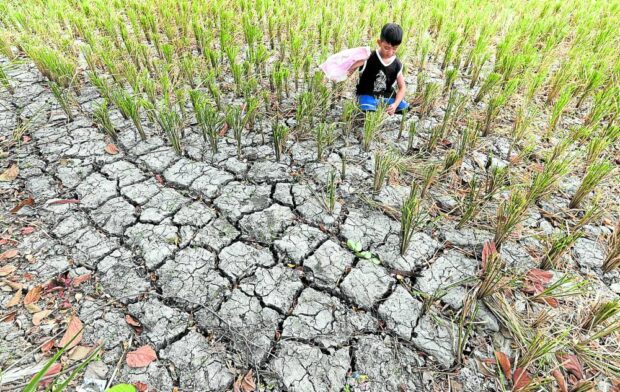Marcos revives Task Force El Niño as threat of drought looms

El Niño is forecast to reduce rainfall and cause farms to dry up, such as this parched field in Tanza, Cavite, photographed on May 3, 2023. (File photo by MARIANNE BERMUDEZ / Philippine Daily Inquirer0
MANILA, Philippines — President Ferdinand Marcos Jr. has revived the Task Force El Niño in anticipation of the weather phenomenon that is expected to cause drought and dry spells in different parts of the country.
Secretary Gilbert Teodoro Jr., who chairs the task force as the head of the Department of National Defense (DND), confirmed this on Tuesday after a Cabinet meeting presided over by Marcos.
“We are here to report what happened in the 15th Cabinet meeting of our resident. That’s the reactivation of the Task Force El Niño or TFEL. Our president will release an executive order for us to prepare early and quickly resolve the possible interventions, and for us to continue monitoring and preparing for the possible effects of El Niño,” Teodoro said in Filipino.
According to him, Executive Order No. 16, which created the task force in 2001, was amended under the National Action Plan submitted by the National Economic and Development Authority (Neda).
“There was already a Task Force El Niño in 2001, under Executive Order No. 16. This was revived but was revised by our president today, and there is already a National Action Plan created by Neda, submitted by our president, and created based on this was the task force,” Teodoro said.
Article continues after this advertisementDrought vs dry spell
Aside from these, the task force Force co-chair, Science and Technology Secretary Renato Solidum Jr., announced that the latest assessments from the Department of Science and Technology (DOST) and the Philippine Atmospheric, Geophysical and Astronomical Services Administration (Pagasa) showed that the peak of the drought and dry spells due to El Niño would be in April 2024, and not May as initially reported.
Pagasa characterizes El Niño as the unusual rise in average sea surface temperatures in the central and eastern equatorial Pacific, resulting in warmer waters. As an effect, below-normal rainfall is expected, which can cause dry spells and droughts in several areas.
“Based on the latest DOST-Pagasa monitoring and assessment on the latest information provided by the Climate Prediction Center of the National Oceanic and Atmospheric Administration of the US, strong El Niño is expected to continue through December, January of 2024, and majority of the global climate model would suggest that El Niño would still persist until March, April, to May 2024,” Solidum said.
“But with the transition to El Niño Southern Oscillation neutral in April, May, to June 2024. So essentially, the effects of El Niño will still be covering the first and second quarter of 2024, but then the peak of El Niño in terms of drought will be April of 2024, which is slightly different from the forecast last week or two weeks ago, that it will be May,” he added.
This means there is a chance that rainfall would be normal or slightly below normal between May and June as the country transitions to a post-El Niño scenario.
“Hence, there will be a possible rainfall, which is normal to slightly below normal by May to June, and hence we can actually still prepare for the effect of El Niño as we have spoken last week. So those are the changes: The drought will peak again in April 2024, with 63 provinces possibly experiencing drought conditions and 12 provinces experiencing the dry spell conditions,” Solidum said.
“Dry spell [and drought] are both the same in Tagalog. The other one [drought] is just more extreme,” he added.
Eastern Mindanao spared from effects
Solidum explained the parameters for a dry spell and a drought, noting that only the eastern side of Mindanao — the Caraga Region and some parts of the Davao Region — might not experience any negative effects.
“For the meteorological definition of dry spell versus drought, if the rainfall is 21 to 60 percent below normal, if there are three consecutive months of that, then it will be called dry spell. If it’s drought, five consecutive months. Now, if on the other hand, it is possible that the rainfall can be way below normal, more than 60 percent, then if there are two consecutive months of way below normal, it will be called [a] dry spell, and three consecutive months, for drought,” Solidum said.
“Now, in terms of the drought, which would peak during April, the provinces that will not be affected by the drought or dry spell would be the Caraga area and some parts of Davao Region, on the eastern side of Mindanao. All the rest are mostly drought or dry spells,” he added.
Just last Friday, Marcos assured the public that the government had been preparing for the El Niño phenomenon, saying that the country’s buffer stock of agricultural products could last up to the first quarter of next year.
During the inauguration of the Poblacion Water Treatment Facility in Muntinlupa City, Marcos said that, since the latest forecasts show a high probability of El Niño during the first and second quarters of 2024, the government had taken steps to push the buffer stock further so that supply would be sufficient.